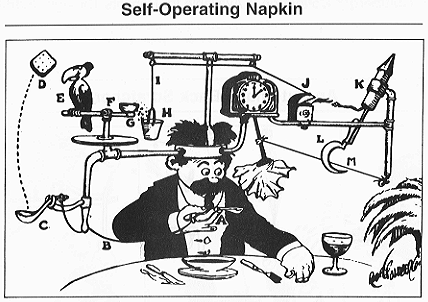The Really Smart Home vs the Internet of Stupid Things
Internet of Things. Smart homes. Smart appliances. Smart everything. How smart is the result?
These days we may buy or self-build “connected kitchen gadgets” like:
- a Smart Grill that can cook almost any food perfectly based on weight, composition, and desired done-ness, all controlled through an iPad app
- an electronic fork that measures how long it took you to eat, the amount of fork servings and the time in between servings. It then uploads that info to an app via USB or Bluetooth to track your eating habits for weight loss

You can also buy or build thousands of less extreme products that let you monitor or operate practically everything in your home, without getting off your chair, if not remotely. The result, we are told, is a “Smart Home”. Apply the same concept to whole urban areas, thanks to the “Internet of Things”, and you get “Smart Cities”. But do you? Or are these just digital versions of Rube Goldberg machines?
We DO need to eat better and save as much energy as possible at home, and to (co-)manage as smartly as possible our cities, transportation system and energy networks. And we cannot get there without using digital devices, networks and services more, and better, than we do now. I am 100% convinced of that!
Stuff like the Bluetooth fork seems to me as much a human advancement as “food for pets stressed by urban life” (yes, there is such a thing). But even most of the other products, and the corresponding lifestyles, aren’t much better. The more stuff like that I see, the more much of the IoT (Internet of Things) looks to me like IoST, the Internet of Stupid Things. And the more the currently marketed “Smart Homes” seem stupid, for reasons even more basic that these ones.
First of all, e-waste. Much of the current offering is hardware deliberately incompatible with other hardware. The same idiocy we’ve been through with cellphone chargers, just 100000 times bigger. Smart? Hardly.
Second, the intrinsical uselessness. A (open-standard!) system that minimizes the energy needed for heating an apartment is good (albeit much less good than a really insulated apartment; more on this later). Stuff that turns your lights on or opens your door as you move from room to room is really necessary (that is “smart”) only for a paralytic person.
Third, family unfriendlyness. As it happens with many other products, many current “smart home”/IoT devices are made to order for the one kind of consumer that markets prefer: the person who lives ALONE, without any permanent relationship. Put that stuff in a family, and it either forces all its members to install the same bundle of apps (if not to have the same brand of smartphones) or to have, for example, one extra tablet just for kitchen work, or to borrow the one with the right apps. Ditto for smart windows, smart music, smart lighting etc. Try to live with that stuff in a home with kids, or even adults, who regularly move from room to room independently, and you’ll see very soon how much smarter it is to turn things on and off manually.
Let me repeat: I’m all for more and better use of digital devices, networks and services, in order to save energy, improve real quality of life and increase citizen participation to public administration. At the same time, I confess I do hope that this kind of “Smart Home” and IoT, dies a quick death soon. No luddism. Just common sense.
Maybe the really Smart Home is the home with as LITTLE digital and connected gadgets as possible. It is a home that does not refuse digital technology, but:
- requires as little maintenance as possible, as low-tech as possible
- contains the smallest possible number of electric/electronic devices (added on 2016/1/12 for extra clarity)
- is built (and lived…) to need so little energy, that it can function with a FEW square meters of fotovoltaic panels hanged outside its balcony or windows
- depends as little as possible on big centralized infrastructure, and is therefore still usable if, for example, some cracker (or the government…) remotely knocks offline the closest power station
- does not have its own 3D printer, CNC mill and so on… not because its occupants refuse technology, but because they can go to a digital DIY service center around the block, to “order copies” of furniture, spare parts for appliances and so on, just like today we go for photocopies to the neighborhood copy shop
- for all the reasons above, besides having the smallest possible environmental footprint, minimizes both the expenses (=debt) and the dependency on all sorts of third parties that it imposes on its occupants
That’s a Smart Home. Not the one with an extra billion of non-recyclable transistors and circuits whose only purpose is to spare you from reading the cooking time on a recipe. Besides, that may be the only Smart Home that people who live in a condo apartment in this real planet need and can afford. And the only one the planet can afford.
Who writes this, why, and how to help
I am Marco Fioretti, tech writer and aspiring polymath doing human-digital research and popularization.
I do it because YOUR civil rights and the quality of YOUR life depend every year more on how software is used AROUND you.
To this end, I have already shared more than a million words on this blog, without any paywall or user tracking, and am sharing the next million through a newsletter, also without any paywall.
The more direct support I get, the more I can continue to inform for free parents, teachers, decision makers, and everybody else who should know more stuff like this. You can support me with paid subscriptions to my newsletter, donations via PayPal (mfioretti@nexaima.net) or LiberaPay, or in any of the other ways listed here.THANKS for your support!